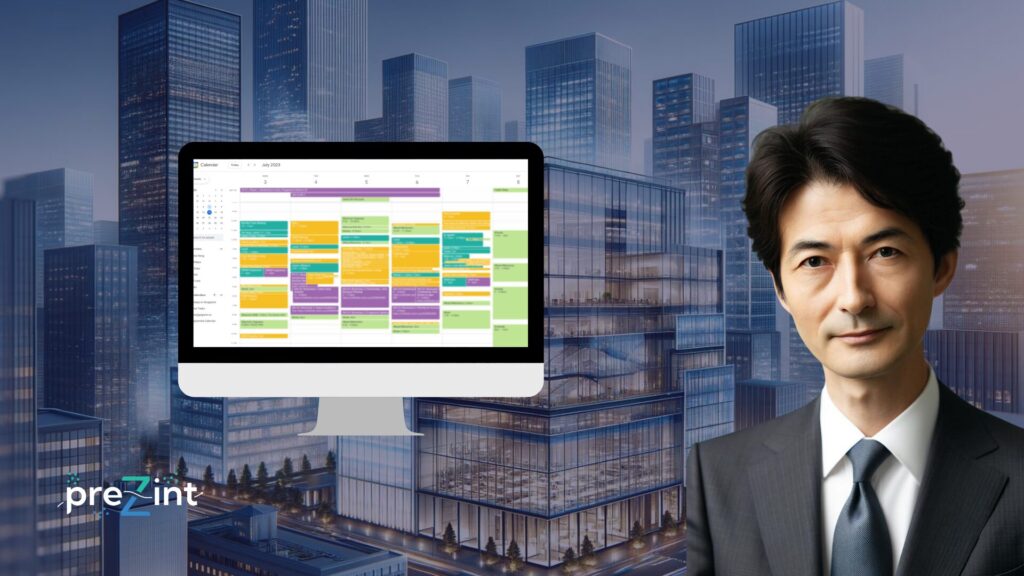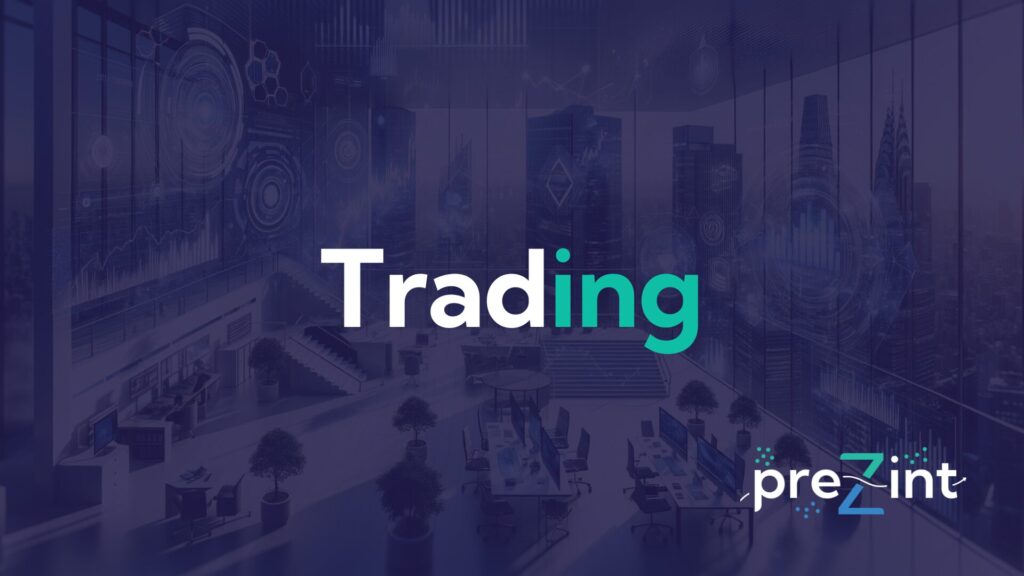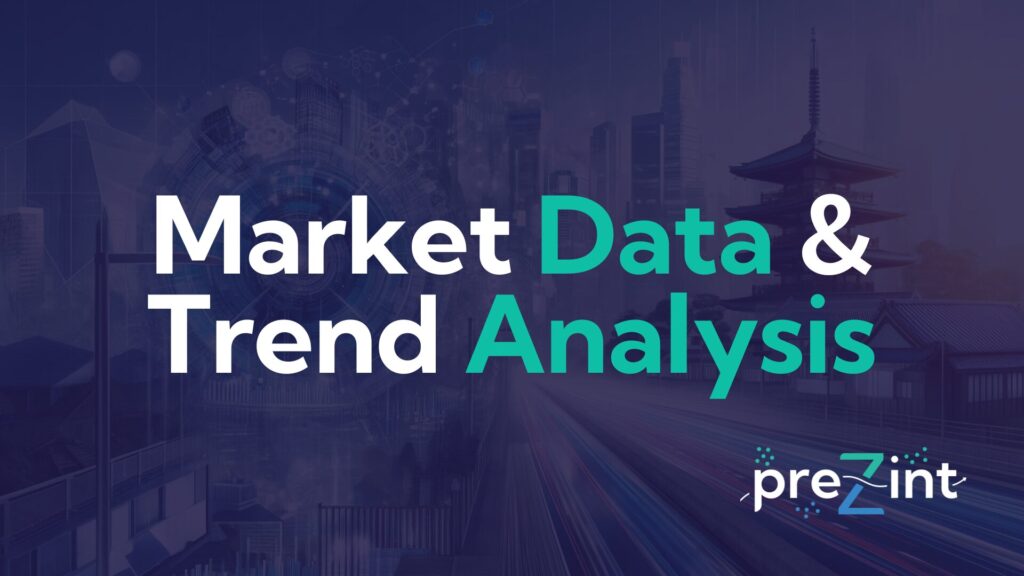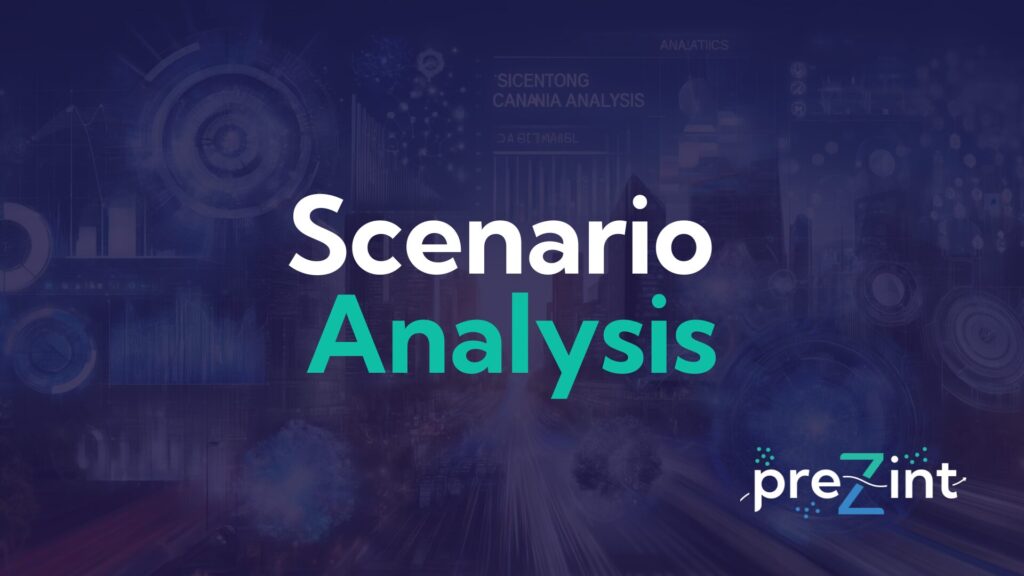Enhancing Trading Strategies
With preZint
In today’s fast-paced global market, trading divisions within
Japanese enterprises, including trading companies, investment
banks, and large corporations, face significant challenges.
Japanese enterprises, including trading companies, investment
banks, and large corporations, face significant challenges.
Integrating fragmented data sources, managing geopolitical
tensions, and ensuring compliance with stringent regulations
are daily hurdles.
tensions, and ensuring compliance with stringent regulations
are daily hurdles.
Effective trading strategies are crucial for navigating these
complexities and seizing market opportunities. preZint offers
comprehensive support, empowering trading divisions to optimize
their strategies and enhance performance.
complexities and seizing market opportunities. preZint offers
comprehensive support, empowering trading divisions to optimize
their strategies and enhance performance.
Key Challenges Faced By
The Trading Division
Data Overload
Trading divisions frequently struggle with data overload, where
critical information is fragmented across multiple systems and platforms:
critical information is fragmented across multiple systems and platforms:
Fragmented Data: Trading divisions manage vast amounts of data from
multiple sources, including market data, financial reports, and supply chain
metrics. This data is often fragmented and stored in various formats, making
it challenging to compile and analyze effectively. For instance, market data
might be stored in real-time streaming formats, financial reports in PDFs,
and supply chain metrics in spreadsheets.
multiple sources, including market data, financial reports, and supply chain
metrics. This data is often fragmented and stored in various formats, making
it challenging to compile and analyze effectively. For instance, market data
might be stored in real-time streaming formats, financial reports in PDFs,
and supply chain metrics in spreadsheets.
Manual Data Transfer: The process of manually transferring and consolidating
data from different systems is labor-intensive and prone to errors. This often
involves significant operational costs, including the labor required to collect,
clean, and integrate the data. For example, a trader might have to manually
export market data from a Bloomberg terminal, import it into a spreadsheet,
and then cross-reference it with financial reports downloaded from different
sources.
data from different systems is labor-intensive and prone to errors. This often
involves significant operational costs, including the labor required to collect,
clean, and integrate the data. For example, a trader might have to manually
export market data from a Bloomberg terminal, import it into a spreadsheet,
and then cross-reference it with financial reports downloaded from different
sources.
High Volume of Data: Trading divisions deal with enormous volumes of data
that need to be processed and analyzed in real time. The sheer quantity of data
can overwhelm existing systems and make it difficult to extract meaningful insights
quickly. For example, monitoring real-time price changes, tracking financial news,
and analyzing historical market trends simultaneously can strain the division’s
analytical capabilities.
that need to be processed and analyzed in real time. The sheer quantity of data
can overwhelm existing systems and make it difficult to extract meaningful insights
quickly. For example, monitoring real-time price changes, tracking financial news,
and analyzing historical market trends simultaneously can strain the division’s
analytical capabilities.
Inconsistent Data Formats: Different data formats, such as PDFs, spreadsheets,
and real-time feeds, complicate the integration process. This inconsistency
requires additional steps to standardize the data before it can be analyzed.
For example, converting real-time market data feeds into a format that can
be compared with static financial reports adds complexity and potential for
errors.
and real-time feeds, complicate the integration process. This inconsistency
requires additional steps to standardize the data before it can be analyzed.
For example, converting real-time market data feeds into a format that can
be compared with static financial reports adds complexity and potential for
errors.
These challenges hinder the ability to access real-time, accurate data, leading
to inefficiencies and missed opportunities for optimization. The inability to
quickly consolidate and analyze data from multiple sources can delay critical
decisions and reduce overall operational efficiency.
to inefficiencies and missed opportunities for optimization. The inability to
quickly consolidate and analyze data from multiple sources can delay critical
decisions and reduce overall operational efficiency.
Market Volatility
Trading divisions frequently struggle with market volatility, where
rapid fluctuations in commodity prices, currency exchange rates,
and financial markets create significant challenges:
rapid fluctuations in commodity prices, currency exchange rates,
and financial markets create significant challenges:
Rapid Market Fluctuations: The global market is highly volatile, with
frequent and unpredictable changes in commodity prices, currency
exchange rates, and stock values. Trading divisions must navigate this
volatility to maximize profits and minimize risks. For example, the price
of crude oil can fluctuate significantly within a single trading day due to
geopolitical events, leading to rapid changes in trading strategies.
frequent and unpredictable changes in commodity prices, currency
exchange rates, and stock values. Trading divisions must navigate this
volatility to maximize profits and minimize risks. For example, the price
of crude oil can fluctuate significantly within a single trading day due to
geopolitical events, leading to rapid changes in trading strategies.
Impact of Social Media: The advent of social media and other modern
communication mediums has accelerated the speed and impact of market
volatility. Information spreads quickly through platforms like twitter, leading to more
pronounced and unpredictable market movements. For instance, a tweet from a
key industry influencer or a sudden news announcement can cause immediate
and significant shifts in market prices.
communication mediums has accelerated the speed and impact of market
volatility. Information spreads quickly through platforms like twitter, leading to more
pronounced and unpredictable market movements. For instance, a tweet from a
key industry influencer or a sudden news announcement can cause immediate
and significant shifts in market prices.
Lack of Real-Time Data: Without access to real-time data from a vast array
of sources, trading divisions are left vulnerable to sudden market shifts.
Traditional methods of data gathering may not provide the speed and breadth
of information needed to react quickly. For example, relying solely on periodic
financial reports can leave traders unaware of real-time market changes, leading
to delayed responses and potential financial losses.
of sources, trading divisions are left vulnerable to sudden market shifts.
Traditional methods of data gathering may not provide the speed and breadth
of information needed to react quickly. For example, relying solely on periodic
financial reports can leave traders unaware of real-time market changes, leading
to delayed responses and potential financial losses.
These challenges hinder the ability to make timely, informed decisions, leading to
potential financial losses and missed trading opportunities. The inability to quickly
access and analyze real-time data from multiple sources leaves trading divisions
at a significant disadvantage in a highly volatile market environment.
potential financial losses and missed trading opportunities. The inability to quickly
access and analyze real-time data from multiple sources leaves trading divisions
at a significant disadvantage in a highly volatile market environment.
Risk Management
Trading divisions frequently struggle with risk management, where
identifying, assessing, and mitigating risks is a continuous challenge:
identifying, assessing, and mitigating risks is a continuous challenge:
Geopolitical Tensions: Political instability, such as conflicts, trade wars,
and changes in government policies, can introduce substantial risks
to trading operations. Geopolitical events can disrupt supply chains,
alter market dynamics, and lead to unexpected financial impacts.
For example, escalating trade tensions between major economies can
lead to tariffs and trade barriers, affecting global market conditions and
trading decisions.
and changes in government policies, can introduce substantial risks
to trading operations. Geopolitical events can disrupt supply chains,
alter market dynamics, and lead to unexpected financial impacts.
For example, escalating trade tensions between major economies can
lead to tariffs and trade barriers, affecting global market conditions and
trading decisions.
Counterparty Risk: Counterparty risk arises when the other party in
a trading transaction fails to fulfill their contractual obligations. This
can happen due to financial instability, bankruptcy, or other unforeseen
issues. For example, a supplier might default on a contract due to financial
difficulties, leading to disruptions in the supply chain and impacting trading
outcomes.
a trading transaction fails to fulfill their contractual obligations. This
can happen due to financial instability, bankruptcy, or other unforeseen
issues. For example, a supplier might default on a contract due to financial
difficulties, leading to disruptions in the supply chain and impacting trading
outcomes.
These challenges make it difficult to proactively manage risks, leading
to potential financial losses and missed opportunities. The inability to
quickly identify and assess risks from multiple sources leaves trading
divisions at a significant disadvantage in a complex and dynamic market
environment.
to potential financial losses and missed opportunities. The inability to
quickly identify and assess risks from multiple sources leaves trading
divisions at a significant disadvantage in a complex and dynamic market
environment.
Regulatory Compliance
Trading divisions frequently struggle with regulatory compliance,
where navigating complex regulatory environments is crucial:
where navigating complex regulatory environments is crucial:
Diverse Regional Regulations: Regulatory requirements can vary
significantly between regions, adding layers of complexity to trading
operations. For example, a trading division might need to comply with
environmental regulations in the European Union, financial reporting
standards in the United States, and labor laws in Asia. Each region’s
specific regulations require detailed knowledge and careful management
to ensure full compliance across all markets.
significantly between regions, adding layers of complexity to trading
operations. For example, a trading division might need to comply with
environmental regulations in the European Union, financial reporting
standards in the United States, and labor laws in Asia. Each region’s
specific regulations require detailed knowledge and careful management
to ensure full compliance across all markets.
Lack of Real-Time Updates: Not having real-time updates when regulatory
changes occur can lead to significant compliance issues. For instance, a
sudden change in trade tariffs between countries could affect the cost and
legality of certain transactions. Without real-time information, the trading
division might unknowingly violate new regulations, resulting in fines or
legal action.
changes occur can lead to significant compliance issues. For instance, a
sudden change in trade tariffs between countries could affect the cost and
legality of certain transactions. Without real-time information, the trading
division might unknowingly violate new regulations, resulting in fines or
legal action.
Monitoring Geopolitical Landscapes: Without the ability to monitor live
changes in geopolitical landscapes through various mediums, trading
divisions may find themselves reacting to events rather than proactively
managing compliance. Geopolitical events, such as sanctions, diplomatic
conflicts, or political unrest, can quickly alter the regulatory environment.
For example, a new sanction on a trading partner country could immediately
impact ongoing transactions and contractual obligations.
changes in geopolitical landscapes through various mediums, trading
divisions may find themselves reacting to events rather than proactively
managing compliance. Geopolitical events, such as sanctions, diplomatic
conflicts, or political unrest, can quickly alter the regulatory environment.
For example, a new sanction on a trading partner country could immediately
impact ongoing transactions and contractual obligations.
These challenges make it difficult for trading divisions to maintain
compliance, leading to potential legal penalties and reputational
damage. The inability to quickly adapt to regulatory changes and
geopolitical shifts can put the company at significant risk.
compliance, leading to potential legal penalties and reputational
damage. The inability to quickly adapt to regulatory changes and
geopolitical shifts can put the company at significant risk.
How preZint Supports
The Trading Division
Centralized Data Management
Solution: preZint integrates diverse data sources from various trading
systems into a single, unified platform. This integration is achieved using
advanced connectors that can handle different data formats and systems,
including trade management systems (TMS), order management systems
(OMS), market data feeds, and financial databases. Our team provides
on-site assistance to ensure seamless data integration tailored to the
enterprise’s specific needs.
systems into a single, unified platform. This integration is achieved using
advanced connectors that can handle different data formats and systems,
including trade management systems (TMS), order management systems
(OMS), market data feeds, and financial databases. Our team provides
on-site assistance to ensure seamless data integration tailored to the
enterprise’s specific needs.
Benefit: This real-time integration eliminates data silos, ensuring that
trading teams have immediate access to accurate, consolidated data.
It significantly reduces the manual effort required to compile and verify
information, enabling faster and more informed decision-making.
trading teams have immediate access to accurate, consolidated data.
It significantly reduces the manual effort required to compile and verify
information, enabling faster and more informed decision-making.
Example: A trading division dealing with multiple data sources, such as
Bloomberg Terminal for market data, internal OMS for order tracking,
and ERP systems for financial reporting, can use preZint to aggregate
data from each system. This unified view allows the team to quickly
identify market opportunities and respond proactively, reducing the
risk of missed trades due to delayed data compilation.
Bloomberg Terminal for market data, internal OMS for order tracking,
and ERP systems for financial reporting, can use preZint to aggregate
data from each system. This unified view allows the team to quickly
identify market opportunities and respond proactively, reducing the
risk of missed trades due to delayed data compilation.
Advanced Market Analytics
Solution: preZint provides advanced market analytics by integrating
real-time data from various sources into its digital platform. This
includes data from a database of 1,500,000 companies with over
25,000,000 data points per company, as well as real-time updates
from SNS, search engines, and other digital mediums. The platform
allows for the execution of complex scenario analyses, ensuring that
these simulations are run on the most up-to-date information possible.
preZint’s on-site personnel customize the data integration process to
meet the specific needs and preferences of each enterprise, ensuring
the system aligns perfectly with their trading strategies and objectives.
real-time data from various sources into its digital platform. This
includes data from a database of 1,500,000 companies with over
25,000,000 data points per company, as well as real-time updates
from SNS, search engines, and other digital mediums. The platform
allows for the execution of complex scenario analyses, ensuring that
these simulations are run on the most up-to-date information possible.
preZint’s on-site personnel customize the data integration process to
meet the specific needs and preferences of each enterprise, ensuring
the system aligns perfectly with their trading strategies and objectives.
Benefit: This real-time integration allows for advanced market analytics,
helping traders analyze market trends, anticipate market movements,
and develop data-driven strategies to maximize profits and minimize
risks. Analysts can run complex simulations, obtain outcomes in minutes,
and utilize our AI assistant for deeper insights.
helping traders analyze market trends, anticipate market movements,
and develop data-driven strategies to maximize profits and minimize
risks. Analysts can run complex simulations, obtain outcomes in minutes,
and utilize our AI assistant for deeper insights.
Example: Before using preZint, a trading team might have relied on
manual methods to compile real-time data and insights, a process
that is time-consuming and prone to delays. With preZint, the team
can analyze real-time data from various sources to forecast currency
movements accurately. For instance, when anticipating a central bank
policy change, such as an interest rate adjustment by the Bank of Japan,
preZint can simulate its impact on forex markets. The simulations reveal
potential changes in currency valuation, helping traders to adjust their
strategies by hedging positions or reallocating assets, thereby minimizing
risks and maximizing profits.
manual methods to compile real-time data and insights, a process
that is time-consuming and prone to delays. With preZint, the team
can analyze real-time data from various sources to forecast currency
movements accurately. For instance, when anticipating a central bank
policy change, such as an interest rate adjustment by the Bank of Japan,
preZint can simulate its impact on forex markets. The simulations reveal
potential changes in currency valuation, helping traders to adjust their
strategies by hedging positions or reallocating assets, thereby minimizing
risks and maximizing profits.
Risk Management & Mitigation
Solution: preZint’s risk management features leverage predictive
analytics and scenario planning to provide comprehensive risk
assessments. By analyzing real-time data from diverse sources,
preZint helps traders identify potential risks early and develop
strategies to mitigate them. The platform allows the trading
division to run hundreds of scenario analyses on real-time data,
with each scenario taking only a few minutes to run. The reasoning
and outcomes of these scenarios can be easily checked through
simple dashboards, and our AI assistant is available to answer
questions and provide additional context. Our on-site team
customizes the integration and risk management setup to ensure
it aligns perfectly with the specific risk profiles and trading strategies
of the enterprise.
analytics and scenario planning to provide comprehensive risk
assessments. By analyzing real-time data from diverse sources,
preZint helps traders identify potential risks early and develop
strategies to mitigate them. The platform allows the trading
division to run hundreds of scenario analyses on real-time data,
with each scenario taking only a few minutes to run. The reasoning
and outcomes of these scenarios can be easily checked through
simple dashboards, and our AI assistant is available to answer
questions and provide additional context. Our on-site team
customizes the integration and risk management setup to ensure
it aligns perfectly with the specific risk profiles and trading strategies
of the enterprise.
Benefit: By providing real-time insights into potential risks, preZint
enables trading teams to proactively address issues before they impact
trading operations. This reduces the likelihood of significant losses due
to unforeseen market fluctuations, geopolitical events, or regulatory
changes.
enables trading teams to proactively address issues before they impact
trading operations. This reduces the likelihood of significant losses due
to unforeseen market fluctuations, geopolitical events, or regulatory
changes.
Example: A trading division facing potential geopolitical tensions can
use preZint to simulate various scenarios and assess their impact on
trading positions. For instance, they can analyze the effects of new
trade sanctions on specific markets and adjust their strategies to
minimize exposure. The ability to run these simulations quickly and
accurately helps the team stay ahead of potential risks.
use preZint to simulate various scenarios and assess their impact on
trading positions. For instance, they can analyze the effects of new
trade sanctions on specific markets and adjust their strategies to
minimize exposure. The ability to run these simulations quickly and
accurately helps the team stay ahead of potential risks.
Regulatory Compliance
Solution: preZint ensures compliance with regulatory requirements
through real-time updates and automated reporting. The platform
continuously monitors changes in regulations and geopolitical landscapes
through various mediums such as SNS, search engines, and financial
markets. This comprehensive monitoring allows trading divisions to see
potential outcomes and understand the reasoning behind different regulatory
changes, ensuring they can adapt quickly and maintain compliance. Our
on-site personnel also help customize the regulatory compliance features to
fit the specific needs of each trading division, ensuring that all relevant
regulations are tracked and managed effectively.
through real-time updates and automated reporting. The platform
continuously monitors changes in regulations and geopolitical landscapes
through various mediums such as SNS, search engines, and financial
markets. This comprehensive monitoring allows trading divisions to see
potential outcomes and understand the reasoning behind different regulatory
changes, ensuring they can adapt quickly and maintain compliance. Our
on-site personnel also help customize the regulatory compliance features to
fit the specific needs of each trading division, ensuring that all relevant
regulations are tracked and managed effectively.
Benefit: By maintaining up-to-date regulatory insights, preZint ensures
that the trading division stays compliant with all relevant regulations.
This proactive approach helps avoid costly fines and legal issues, upholds
the company’s reputation, and supports ethical and legal trading practices.
that the trading division stays compliant with all relevant regulations.
This proactive approach helps avoid costly fines and legal issues, upholds
the company’s reputation, and supports ethical and legal trading practices.
Example: When new environmental regulations impacting carbon emissions
standards are introduced, preZint can alert the trading team about these
changes. The platform can simulate scenarios to identify which trades or
investments are most at risk of non-compliance and recommend necessary
adjustments. preZint can suggest potential new trading strategies that align
with the updated regulatory standards, ensuring the company remains compliant
while optimizing its trading operations.
standards are introduced, preZint can alert the trading team about these
changes. The platform can simulate scenarios to identify which trades or
investments are most at risk of non-compliance and recommend necessary
adjustments. preZint can suggest potential new trading strategies that align
with the updated regulatory standards, ensuring the company remains compliant
while optimizing its trading operations.
Conclusion
preZint plays a critical role in supporting the trading divisions of various
enterprises by providing a comprehensive, data-driven approach to
decision-making.
enterprises by providing a comprehensive, data-driven approach to
decision-making.
By centralizing data, enhancing analytics, improving collaboration,
supporting strategic planning, and managing risks, preZint empowers
trading divisions to lead their enterprises toward sustained growth
and success in a competitive global market.
supporting strategic planning, and managing risks, preZint empowers
trading divisions to lead their enterprises toward sustained growth
and success in a competitive global market.
Next Steps
If you’re ready to see how preZint can transform your trading
processes and drive your enterprise forward, book a demo today.
processes and drive your enterprise forward, book a demo today.
Enhancing Trading Strategies With preZint
In today’s fast-paced global market, trading divisions within Japanese enterprises, including trading companies, investment
banks, and large corporations, face significant challenges.
Integrating fragmented data sources, managing geopolitical
tensions, and ensuring compliance with stringent regulations are daily hurdles.
Effective trading strategies are crucial for navigating these
complexities and seizing market opportunities. preZint offers comprehensive support, empowering trading divisions to optimize
their strategies and enhance performance.
Key Challenges Faced By
The Trading Division
Data Overload
Trading divisions frequently struggle with data overload, where critical information is fragmented across multiple systems and platforms:
Fragmented Data: Trading divisions manage vast amounts of data from multiple sources, including market data, financial reports, and supply chain
metrics. This data is often fragmented and stored in various formats, making
it challenging to compile and analyze effectively. For instance, market data
might be stored in real-time streaming formats, financial reports in PDFs,
and supply chain metrics in spreadsheets.
Manual Data Transfer: The process of manually transferring and consolidating
data from different systems is labor-intensive and prone to errors. This often
involves significant operational costs, including the labor required to collect,
clean, and integrate the data. For example, a trader might have to manually
export market data from a Bloomberg terminal, import it into a spreadsheet,
and then cross-reference it with financial reports downloaded from different
sources.
High Volume of Data: Trading divisions deal with enormous volumes of data that need to be processed and analyzed in real time. The sheer quantity of data
can overwhelm existing systems and make it difficult to extract meaningful insights
quickly. For example, monitoring real-time price changes, tracking financial news,
and analyzing historical market trends simultaneously can strain the division’s
analytical capabilities.
Inconsistent Data Formats: Different data formats, such as PDFs, spreadsheets, and real-time feeds, complicate the integration process. This inconsistency
requires additional steps to standardize the data before it can be analyzed.
For example, converting real-time market data feeds into a format that can
be compared with static financial reports adds complexity and potential for
errors.
These challenges hinder the ability to access real-time, accurate data, leading
to inefficiencies and missed opportunities for optimization. The inability to
quickly consolidate and analyze data from multiple sources can delay critical
decisions and reduce overall operational efficiency.
Market Volatility
Trading divisions frequently struggle with market volatility, where rapid fluctuations in commodity prices, currency exchange rates,
and financial markets create significant challenges:
Rapid Market Fluctuations: The global market is highly volatile, with
frequent and unpredictable changes in commodity prices, currency exchange rates, and stock values. Trading divisions must navigate this
volatility to maximize profits and minimize risks. For example, the price
of crude oil can fluctuate significantly within a single trading day due to
geopolitical events, leading to rapid changes in trading strategies.
Impact of Social Media: The advent of social media and other modern communication mediums has accelerated the speed and impact of market
volatility. Information spreads quickly through platforms like twitter, leading to more
pronounced and unpredictable market movements. For instance, a tweet from a
key industry influencer or a sudden news announcement can cause immediate
and significant shifts in market prices.
Lack of Real-Time Data: Without access to real-time data from a vast array
of sources, trading divisions are left vulnerable to sudden market shifts. Traditional methods of data gathering may not provide the speed and breadth
of information needed to react quickly. For example, relying solely on periodic
financial reports can leave traders unaware of real-time market changes, leading
to delayed responses and potential financial losses.
These challenges hinder the ability to make timely, informed decisions, leading to
potential financial losses and missed trading opportunities. The inability to quickly
access and analyze real-time data from multiple sources leaves trading divisions
at a significant disadvantage in a highly volatile market environment.
Risk Management
Trading divisions frequently struggle with risk management, where identifying, assessing, and mitigating risks is a continuous challenge:
Geopolitical Tensions: Political instability, such as conflicts, trade wars,
and changes in government policies, can introduce substantial risks
to trading operations. Geopolitical events can disrupt supply chains,
alter market dynamics, and lead to unexpected financial impacts.
For example, escalating trade tensions between major economies can
lead to tariffs and trade barriers, affecting global market conditions and
trading decisions.
Counterparty Risk: Counterparty risk arises when the other party in
a trading transaction fails to fulfill their contractual obligations. This can happen due to financial instability, bankruptcy, or other unforeseen
issues. For example, a supplier might default on a contract due to financial
difficulties, leading to disruptions in the supply chain and impacting trading
outcomes.
These challenges make it difficult to proactively manage risks, leading
to potential financial losses and missed opportunities. The inability to quickly identify and assess risks from multiple sources leaves trading
divisions at a significant disadvantage in a complex and dynamic market
environment.
Regulatory Compliance
Trading divisions frequently struggle with regulatory compliance, where navigating complex regulatory environments is crucial:
Diverse Regional Regulations: Regulatory requirements can vary significantly between regions, adding layers of complexity to trading
operations. For example, a trading division might need to comply with
environmental regulations in the European Union, financial reporting
standards in the United States, and labor laws in Asia. Each region’s
specific regulations require detailed knowledge and careful management
to ensure full compliance across all markets.
Lack of Real-Time Updates: Not having real-time updates when regulatory changes occur can lead to significant compliance issues. For instance, a
sudden change in trade tariffs between countries could affect the cost and
legality of certain transactions. Without real-time information, the trading
division might unknowingly violate new regulations, resulting in fines or
legal action.
Monitoring Geopolitical Landscapes: Without the ability to monitor live
changes in geopolitical landscapes through various mediums, trading
divisions may find themselves reacting to events rather than proactively
managing compliance. Geopolitical events, such as sanctions, diplomatic
conflicts, or political unrest, can quickly alter the regulatory environment.
For example, a new sanction on a trading partner country could immediately
impact ongoing transactions and contractual obligations.
These challenges make it difficult for trading divisions to maintain
compliance, leading to potential legal penalties and reputational damage. The inability to quickly adapt to regulatory changes and
geopolitical shifts can put the company at significant risk.
How preZint Supports
The Trading Division
Centralized Data Management
Solution: preZint integrates diverse data sources from various trading
systems into a single, unified platform. This integration is achieved using advanced connectors that can handle different data formats and systems,
including trade management systems (TMS), order management systems
(OMS), market data feeds, and financial databases. Our team provides
on-site assistance to ensure seamless data integration tailored to the
enterprise’s specific needs.
Benefit: This real-time integration eliminates data silos, ensuring that trading teams have immediate access to accurate, consolidated data.
It significantly reduces the manual effort required to compile and verify
information, enabling faster and more informed decision-making.
Example: A trading division dealing with multiple data sources, such as Bloomberg Terminal for market data, internal OMS for order tracking,
and ERP systems for financial reporting, can use preZint to aggregate
data from each system. This unified view allows the team to quickly
identify market opportunities and respond proactively, reducing the
risk of missed trades due to delayed data compilation.
Advanced Market Analytics
Solution: preZint provides advanced market analytics by integrating real-time data from various sources into its digital platform. This
includes data from a database of 1,500,000 companies with over
25,000,000 data points per company, as well as real-time updates
from SNS, search engines, and other digital mediums. The platform
allows for the execution of complex scenario analyses, ensuring that
these simulations are run on the most up-to-date information possible.
preZint’s on-site personnel customize the data integration process to
meet the specific needs and preferences of each enterprise, ensuring
the system aligns perfectly with their trading strategies and objectives.
Benefit: This real-time integration allows for advanced market analytics,
helping traders analyze market trends, anticipate market movements, and develop data-driven strategies to maximize profits and minimize
risks. Analysts can run complex simulations, obtain outcomes in minutes,
and utilize our AI assistant for deeper insights.
Example: Before using preZint, a trading team might have relied on
manual methods to compile real-time data and insights, a process that is time-consuming and prone to delays. With preZint, the team
can analyze real-time data from various sources to forecast currency
movements accurately. For instance, when anticipating a central bank
policy change, such as an interest rate adjustment by the Bank of Japan,
preZint can simulate its impact on forex markets. The simulations reveal
potential changes in currency valuation, helping traders to adjust their
strategies by hedging positions or reallocating assets, thereby minimizing
risks and maximizing profits.
Risk Management & Mitigation
Solution: preZint’s risk management features leverage predictive analytics and scenario planning to provide comprehensive risk
assessments. By analyzing real-time data from diverse sources,
preZint helps traders identify potential risks early and develop
strategies to mitigate them. The platform allows the trading
division to run hundreds of scenario analyses on real-time data,
with each scenario taking only a few minutes to run. The reasoning
and outcomes of these scenarios can be easily checked through
simple dashboards, and our AI assistant is available to answer
questions and provide additional context. Our on-site team
customizes the integration and risk management setup to ensure
it aligns perfectly with the specific risk profiles and trading strategies
of the enterprise.
Benefit: By providing real-time insights into potential risks, preZint
enables trading teams to proactively address issues before they impact
trading operations. This reduces the likelihood of significant losses due
to unforeseen market fluctuations, geopolitical events, or regulatory
changes.
Example: A trading division facing potential geopolitical tensions can use preZint to simulate various scenarios and assess their impact on
trading positions. For instance, they can analyze the effects of new
trade sanctions on specific markets and adjust their strategies to
minimize exposure. The ability to run these simulations quickly and
accurately helps the team stay ahead of potential risks.
Regulatory Compliance
Solution: preZint ensures compliance with regulatory requirements through real-time updates and automated reporting. The platform
continuously monitors changes in regulations and geopolitical landscapes
through various mediums such as SNS, search engines, and financial
markets. This comprehensive monitoring allows trading divisions to see
potential outcomes and understand the reasoning behind different regulatory
changes, ensuring they can adapt quickly and maintain compliance. Our
on-site personnel also help customize the regulatory compliance features to
fit the specific needs of each trading division, ensuring that all relevant
regulations are tracked and managed effectively.
Benefit: By maintaining up-to-date regulatory insights, preZint ensures that the trading division stays compliant with all relevant regulations.
This proactive approach helps avoid costly fines and legal issues, upholds
the company’s reputation, and supports ethical and legal trading practices.
Example: When new environmental regulations impacting carbon emissions
standards are introduced, preZint can alert the trading team about these
changes. The platform can simulate scenarios to identify which trades or
investments are most at risk of non-compliance and recommend necessary
adjustments. preZint can suggest potential new trading strategies that align
with the updated regulatory standards, ensuring the company remains compliant
while optimizing its trading operations.
Conclusion
preZint plays a critical role in supporting the trading divisions of various enterprises by providing a comprehensive, data-driven approach to
decision-making.
By centralizing data, enhancing analytics, improving collaboration,
supporting strategic planning, and managing risks, preZint empowers trading divisions to lead their enterprises toward sustained growth
and success in a competitive global market.
Next Steps
If you’re ready to see how preZint can transform your trading processes and drive your enterprise forward, book a demo today.

Book Your Demo
Fill out the form to book your demo. Click green button when done to be directed to the calendar reservation page.
Your privacy is of our upmost concern. We will not share your information with any third parties. You can request that we delete your information at anytime.
Demo Is
What?
Your demo is the next step creating your customized preZint solution.
Below are some of the key points of the demo.
Questionnaire
Complete a questionnaire to understand
your companies specific & unique challenges
Benefit: Tailored insights to ensure
your demo addresses your exact needs

Scheduling
After questionnaire, reserve a date / time for demo.
Demo is held at your office or desired location
Benefit: See preZint live in person

Live Demonstration
A sales representative & our expert will conduct a live demo at your desired location
Benefit: See for you industry how preZint can reduce operational costs by 30%


Book Your Demo
Fill out the form to book your demo
Click green button when done to be directed
to the calendar reservation page.
Your privacy is of our upmost concern. We will not share your information with any third parties. You can request that we delete your information at anytime.
Demo Is
What?
Your demo is the next step creating your customized preZint solution.
Below are some of the key points of the demo.
Below are some of the key points of the demo.
Questionnaire
Complete a questionnaire to understand
your companies specific & unique challenges
your companies specific & unique challenges
Benefit: Tailored insights to ensure
your demo addresses your exact needs
your demo addresses your exact needs


Scheduling
After questionnaire, reserve a date / time for demo.
Demo is held at your office or desired location
Demo is held at your office or desired location
Benefit: See preZint live in person
Live Demonstration
A sales representative & product specialist
will conduct a live demo at your desired location
will conduct a live demo at your desired location
Benefit: See for you industry how preZint
can reduce operational costs by 30%
can reduce operational costs by 30%








